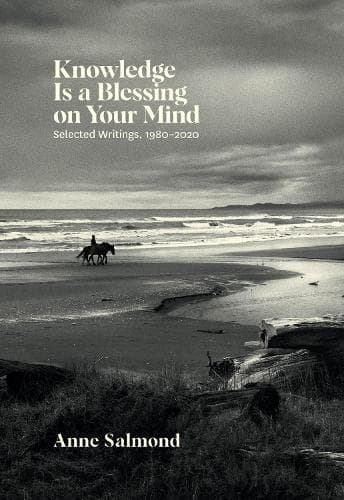Review — Knowledge is a blessing on your mind: Selected Writings, 1980—2020
Reviewed by David Veart
The book’s publication occurs at a time when we are yet again debating the modern meaning of Te Tiriti, with questions on Māori representation on councils, co-governance and suggestions of a referendum on the future of our ‘founding document.’ Against all this Dame Anne Salmond’s latest book presents a more nuanced point of view, a world where engagement with te ao Māori is positive and part of the dynamic wider worlds of Te Moana-nui-a-Kiwa.
In this selection of her writing, everything from exhibition catalogues to academic papers, the author has created an autobiography of the development of her thought, beginnings, influences and responses, all arranged chronologically with a contemporary, and at times wry, commentary.
While I know her major books it is fascinating to see their genesis. The research, the study and scholarships, the field work and her personal responses are described and the academic papers that helped generate the books are here to examine. In academic writing often the way the information has been obtained is masked. I speak to many different groups about my work and a common question is ‘How do you know this?’ I suspect at times when expert opinion is questioned the questioner cannot imagine the amount of work required to achieve the stated expertise. In her role as one of our nation’s leading public intellectuals the author here ‘shows her workings’.
The book is written in a mixture of styles as is to be expected in a selection like this, sometimes academic, sometimes conversational. And she introduces many fascinating people to guide us: her mentors, Eruera and Amiria Stirling, Mau Pialug, the Micronesian navigator who has taught generations of new followers of the star-path, her great-grandfather, James McDonald, film maker and photographer whose work recorded the Māori world of his era. Then there are the stars of Pacific exploration, Tupaia, the navigator priest who provided Cook with a gateway to the people of Polynesia, a man who drew, mapped and translated the Pacific world for his European hosts. Then Cook himself is described in a way that makes him seem very human and his demise not a random event but part of a much more complex set of circumstances.
As well as the longer pieces there are essays here that I am glad have found a permanent home. I remember her ‘Once were warriors’ piece in the NZ Herald, a response to claims that maltreatment of tamariki is in some way part of traditional culture. The evidence she produces to the contrary is compelling.
Central to this book is the chapter on Te Tiriti. This work was produced together with Merimeri Penfold and Cleve Barlow at the request of the Waitangi Tribunal to elaborate on an earlier study on Māori understanding of Te Tiriti in 1840. There is much to think about here; the detailed examination of the events surrounding the signing, a forensic dissection of both the Māori and English versions of the document, the effect of the language of Paipera Tapu, the Māori bible, on how ideas were translated for the treaty text and the effect of war and European contact on the individuals who signed the document. The speeches of the rangatira as recorded by Māori speaking Pākehā at Waitangi are analysed in a sequence which for me conjured up the proceedings better than any account I have seen before. The cut and thrust of Māori oratory, the response of the officials, the jostling of the Pākehā for precedence. ‘I’ll never follow Rome!’ exclaims missionary Richard Taylor as the elaborately clad catholic Bishop Pompallier follows Hobson very, very closely into the tent on Busby’s lawn. Social hierarchy was at work on both sides of the table.
There are descriptions of the travels by many of the chiefs to other parts of the world including Port Jackson, Norfolk Island and London and the effect this may have had in their decision on whether or not to sign. It is noted that the places the chiefs most commonly visited were Port Jackson and Norfolk Island, both penal colonies, leading one chief in a final oratorical gesture to approach Hobson with his wrists crossed indicating he was already prepared for his shackles.
We then leave the chiefs debating what to do with this piece of paper and fast forward 160 years or so to examine the outcome of those deliberations at Waitangi. The discussion here is centred on the implications of the decision that in New Zealand law the Whanganui River is to be treated as a living being. Interleaved is a personal response, Waikereru, an ecological restoration area created by Dame Anne and her much missed husband Jeremy, a personal expression of many of the values we have met in this book. Then back to the river where the legal implications of a living river and their relationship to te ao Māori are inevitably complex. The summary of the different Pākehā and Māori visions of water ownership, protection and use stand as an exemplar of the gulf that still divides the Treaty partners.
This is an important book, I agree with Eruera Stirling that ‘knowledge is a blessing on your mind’ and for sharing that knowledge Dame Anne Salmond, we thank you.
Reviewed by David Veart
